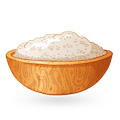MAIN INGREDIENTS
Usually sold by street vendors, this steamed cake is prepared with glutinous rice flour that is flavored and colored with pandan leaves. The mixture is traditionally steamed in bamboo tubes, while the center of the cake is filled with palm sugar.
When steamed, the cake is usually dusted with freshly grated coconut. Kue putu and similar varieties of these convenient green-colored snacks are also found in Malaysia and the Philippines, and some believe that they might have been inspired by puttu—a similar snack of Indian origin.
MAIN INGREDIENTS
In its simplest form, bibingka is a simple Filipino cake that consists of rice flour and water. It was initially prepared in clay pots that were lined with banana leaves, which would impart a distinctive, smoky flavor to the dish. Bibinka is believed to have appeared under the foreign culinary influence, and the first written reference describing a similar cake dates back to 1751.
Through history, bibinka was adapted with additional ingredients, and nowadays it is typically prepared with milk, eggs, coconut milk, sugar, and butter, while modern variations may include anything from grated cheese, salted duck eggs or grated coconut, and a variety of different sweet and savory toppings.
Lapis legit is a traditional layered cake originating from Indonesia, where it's been made under the influence of Dutch cuisine. The cake consists of 18 to 30 separately baked layers of egg yolks, sugar, flour, butter, and spices such as mace, nutmeg, cloves, and cinnamon.
It's essentially the Indonesian version of the European spit cake – however, it's not baked on a rotating spit, but in square-shaped baking pans. It's important not to confuse this cake with kuih lapis (or kue lapis), because lapis legit is baked and not steamed as kue lapis.
MAIN INGREDIENTS
Kue lapis or kuih lapis is a traditional dessert that's also popular in Malaysia, Suriname, Brunei, and Singapore. It is usually prepared as a moist layered pudding-like cake consisting of rice flour, sago, sugar, salt, coconut milk, and red, green, or pink food coloring.
The cake is steamed and the final result looks similar to a layered pudding. Before cutting and serving, kue lapis should be left to cool down completely. If properly prepared, this dessert should have a bouncy, sticky, and chewy texture.
MOST ICONIC Kuih lapis
View moreAlthough undoubtedly French in origin, the decadent sans rival (lit. without rival) is a classic Filipino dessert and an all-time favorite that truly lives up to its name. It is made with layers of dacquoise; a crispy, baked nut meringue sandwiched together with the so-called pâte à bombe - a gorgeously smooth, velvety and rich French buttercream.
But unlike the French original, which is traditionally made with either almond or hazelnut meringue, the Filipino version uses toasted cashews instead. Sans rival is said to have been invented sometime between the 1920s and 1930s, when many Filipinos traveled to Europe to study, and upon returning home to the Philippines, they started employing some of the cooking and patisserie techniques they learned while studying abroad.
MOST ICONIC Sans rival
View moreThis traditional Vietnamese dessert consists of chewy layers that are typically made with puréed mung beans, tapioca starch, rice flour, and coconut milk or water. Traditionally, each cake has a pale yellow layer made with mung beans and a green layer that is flavored and colored with pandan leaves, while optional ingredients include durian or taro.
Once steamed and chilled, the cake is usually cut into diamond shapes.
Bananas are the star ingredient in this classic Vietnamese dessert which can be steamed (hấp) or baked (nướng). It usually consists of sliced bananas and a creamy combination of condensed milk, sugar, coconut milk, and optionally bread, eggs, or shredded coconut.
Depending on the ingredients and the cooking procedure, the cakes can vary in shape and texture, while other varieties come in a form of banana fritters or incorporate additional ingredients and flavorings. Steamed versions are often served sprinkled with sesame seeds and doused in coconut milk.
VARIATIONS OF Bánh chuối
MAIN INGREDIENTS
Kutsinta is a sweet Filipino delicacy made with glutinous rice flour, brown sugar, and lye water. The mixture is steamed in small round molds and it is traditionally served topped with coconut flakes. These chewy cakes are usually infused with food coloring or annatto seeds in order to achieve their typical dark brown color.
These sweet treats are usually enjoyed as a satisfying dessert or a quick afternoon snack.
MOST ICONIC Kutsinta
View moreKuih cara manis is a Malaysian dessert that is made with a batter consisting of eggs, flour, and coconut milk. The cakes are baked in specialized pans and are traditionally flavored with pandan leaves, which also give the cakes their distinctive green color.
While they bake, these bite-sized cakes are occasionally filled with shredded coconut, coconut jam, or palm sugar. They are usually sandwiched together and are typically enjoyed as a teatime dessert.
Bánh chuối hấp is a traditional dessert. This steamed banana cake is made with ripe bananas, rice flour, coconut milk, tapioca starch, and sugar. The bananas are peeled, mashed, then mixed with sugar, rice flour, water, and sometimes vanilla.
The batter is steamed until done, and the cake is then drizzled with a sauce consisting of coconut milk, sugar, water, tapioca starch, and salt. Before serving, bánh chuối hấp is often cut into diamond shapes and sprinkled with crushed peanuts or sesame seeds.
TasteAtlas food rankings are based on the ratings of the TasteAtlas audience, with a series of mechanisms that recognize real users and that ignore bot, nationalist or local patriotic ratings, and give additional value to the ratings of users that the system recognizes as knowledgeable. TasteAtlas Rankings should not be seen as the final global conclusion about food. Their purpose is to promote excellent local foods, instill pride in traditional dishes, and arouse curiosity about dishes you haven’t tried.











